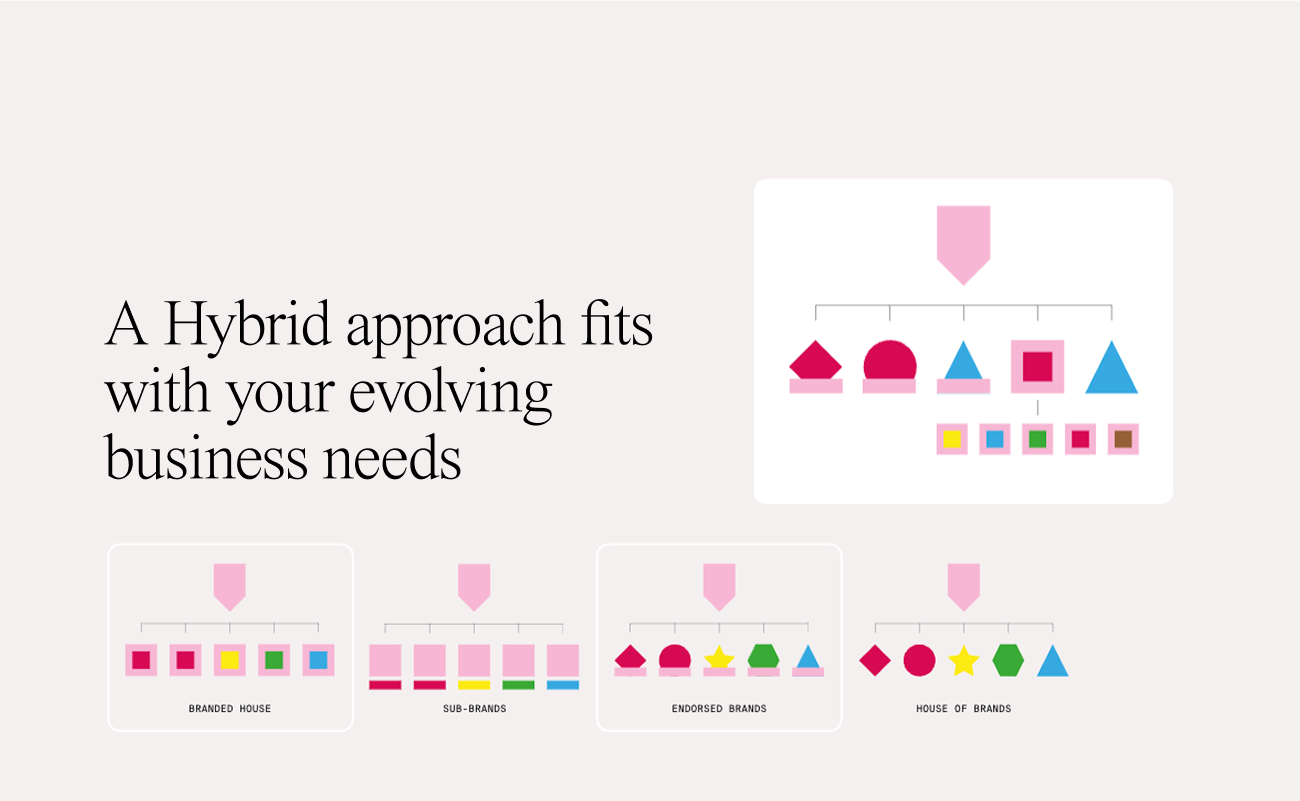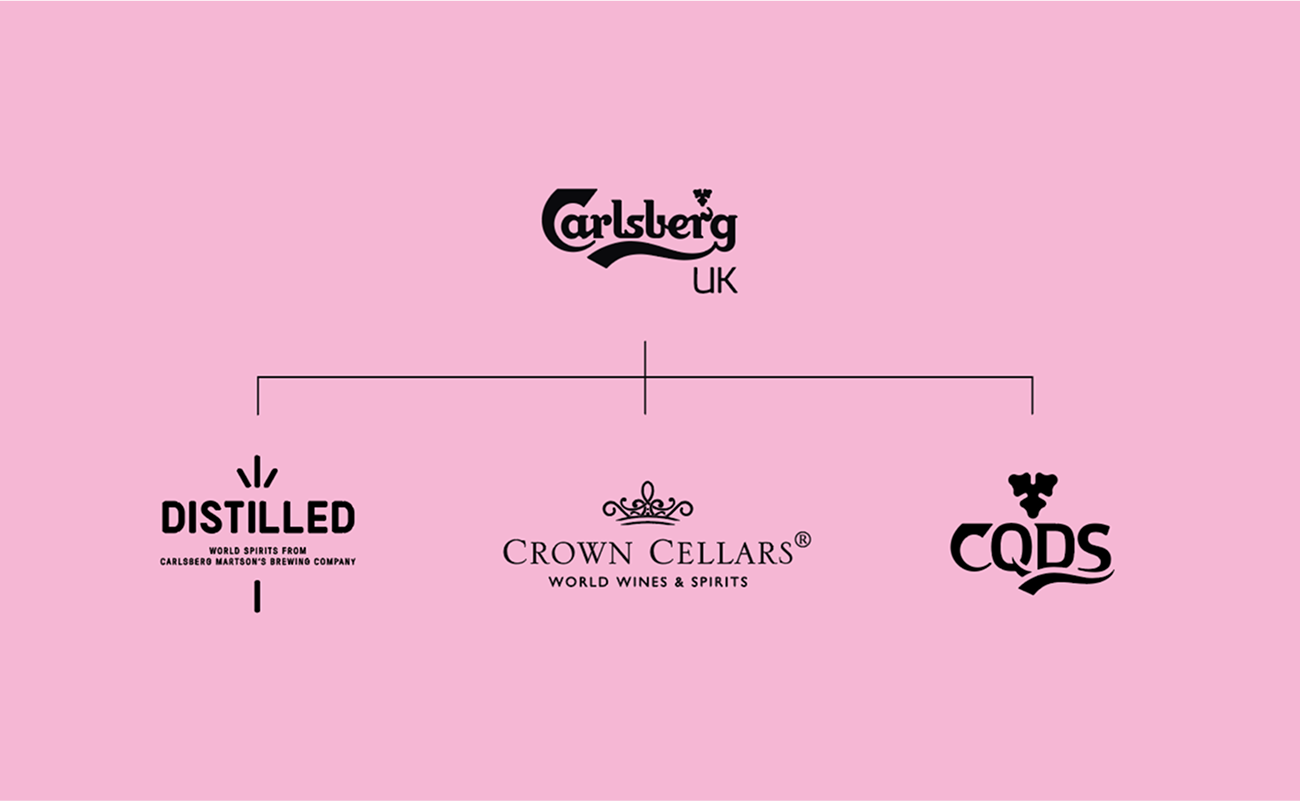Brand & Portfolio Architecture.
Let us refine your brand and portfolio architecture to improve strategic decision making across your business and most effectively leverage your brand.
It is essential that your brand has a clear view and message as the business scales. During the business expansion process, the message is not always portrayed coherently with your sub brands, which can lead to inconsistencies and confusion for your target audiences. Solidifying the tone and brand strategy of each of your brand or product sectors is essential within the brand architecture. In doing so, the overall perception of the parent brand needs to be maintained and benefitted where possible from the sub brands within the portfolio.
Brand & Portfolio Architecture
Now more than ever, structure is needed to clearly communicate a brand. Think of your brand architecture like your brand's blueprint; finding the right key messaging, brand personality and target audience throughout the structure is key in order to establish your customers loyalty across all organisations. Not only will a robust brand architecture secure trust and loyalty across all layers, but it will also future proof your overall structure and show your ability to stay flexible and innovative across the board along with consumer trends.
Here at BGN, our brand architecture analysis process is thorough, to say the least. We offer a full explanation of why brand elements don’t work, or rather, the impression they give and how that conflicts with the image you want to project. We make sure to provide our explanations in such a way that doesn’t get too bogged down in design terminology and intricacies, either. Instead, we clearly convey the best direction for your brand, and in collaboration with yourselves, establish a clear plan moving forward to improve your brand architecture and overall, the success of your business. The documents included in our brand architecture process are primed for passing onto a decision-maker to justify a brand refresh or complete overhaul.
Setting the standard in Brand & Portfolio Architecture
View Project
Thirst
To set the standard in the on-trade sector.
View Project
Gemini Worktops
Setting the standard in affordable luxury home improvements
View Project
Carlsberg UK - Distilled
Redefining a market leaders’ approach to wholesale.
View Project
Fasthosts ProActive
To set the standard in cloud management services.
Consolidating Your Brand Architecture
Brand Architecture
Your brand architecture needs to maintain consistency across all layers of the organisation with growth and development, including any sub brands or products. As part of our brand strategy service, we will assess your existing brand architecture to uncover any inconsistencies and offer strategic changes to support brand alignment and flexibility for future growth. We can then help you to implement these changes, from improving the UX of your website through to brand naming and creating campaigns.

Portfolio Architecture
A well organised portfolio architecture makes for a successful and cohesive brand. We will support you in designing your portfolio architecture, balancing and aligning your current structure whilst mitigating the risk of confusion through change from your key stakeholders.

Portfolio Narratives
What story does your overall portfolio tell? Would you customers be able to identify sister brands or sub brands that fit into your overall brand architecture? A unified story across your entire portfolio architecture will only strengthen the relationship you have with your stakeholders and ensure that a clear hierarchy has been put into place. Your portfolio narrative should also showcase your brand's evolution, including your commitment to making change in line with economical and cultural changes.

Strategy Workshops
We can facilitate strategy workshops with all of your crucial stakeholders when aligning your brand architecture. This is to make sure that everyone has a clear vision of existing weaknesses and strengths, and collaborative in deciding future changes to shape the future of the business.

Our Process As A Brand Architecture Agency
As with any of our processes, we always start off with thinking before doing.
Immersion & Research
Our team will work with you to understand what your current brand architecture consists of, and what type of message it is currently portraying. A brand audit and customer research and insights will play a crucial role in these beginning stages.
Strategy Workshop
We will collaborate with you and key stakeholders during a strategy workshop to take note of all the layers to your organisation. Determining your model at this stage will also streamline the process.
Refinement
Once we have an understanding of your entire brand and portfolio architecture, we will begin to target sub-categories of the organisation that are not cohesive with the overall message. Creating a sense of unity is crucial, therefore identifying any outliers will begin the process of creating a cohesive brand architecture.
Structuring
We will then begin to map out a strategy to create a better structure within your hierarchy. Redirecting and restructuring outliers back towards the interest of the parent brands is key for a consistent message across the organisation.
Implementation
The final step of our brand architecture process will be implementation. You will have the correct structure and tools required after working with our agency to evaluate your success across the entire organisation, whilst also having the versatility across the brand to grow sustainably with market changes.
Portfolio & Brand Strategy FAQ's:
What makes brand architecture so important?
Consider your brand architecture as your company's blueprint. Guiding and identifying your business, brand and portfolio architecture helps your consumers understand how your different sub-brands or products connect to each other and, more importantly, to the parent brand. Nurturing the connection between each sub-brand not only encourages loyalty to your organisation, but can also inherently fuel the sustainable growth of your organisation over time against any environmental, cultural, or trend changes within the industry. Making the most of the resources across your brand architecture essentially provides a sense of familiarity and trust with your family of brands.
What role do sub brands play in brand architecture?
Within your brand architecture, you can have sub-brands that support the overall makeup of your brand portfolio. If businesses hope to present a cohesive brand across their architecture, much attention must be paid to these smaller sub-brands. For example, the parent brand Google hosts sub-brands such as Google Maps, Home and Chrome which all support the foundations of the overall Google empire. Your sub-brands are an extension of your visual identity. In essence, if your sub-brands all portray the same authority, quality and message, this will enhance the overall brand image and maximise potential profits.
Can brand architecture change over time?
Yes, brands that can keep their brand architecture malleable in line with industry changes are known to be the most successful and future-proof. Staying relevant and on-trend is essential for any brand, but there is more at risk for umbrella brands that house sub-brands. Your brand architecture needs to be flexible across the board, and to do this means first solidifying the overall blueprint and brand message that you wish to convey. Changes can be made at any point, whether there is a shift in the market or a change in direction for the overall organisation. No matter what initiates the change in brand architecture, one thing is for certain. Your architecture needs to connect and support each sub brand to some degree to support long-term strategic goals, maintain a good reputation to target audiences and to allow brand innovation with changing landscapes.
What are the main types of brand architecture?
House of Brands - This is a brand architecture by which an organisation manages and houses multiple different brands with their own independent image. With diverse targeting, a house of brands has access to various market segments and does not limit itself to one industry. With each brand having the flexibility to operate as its own entity, the success of one brand will not directly impact the others. In essence, it may be difficult to identify sub-brands that fit into the parent brand of a House of Brands due to its variety in market segmentation.
Endorsed Brands - Endorsed brand architectures are similar to houses of brands, however, the sub-brands still have notable connections to the parent brand that can still be leveraged. Brands such as Kellogg's show the benefits associated with endorsed brand architecture. This allows for cohesive marketing strategies that relate to each brand whilst also highlighting their independence within the entire organisation.
Branded House - This brand architecture involves the parent company being prevalent within each sub-product or service that the brand continues to produce. Each product created within this architecture will follow the same strategy within its branding, logos and packaging, and the recognition between sub-brands to the parent brand is immediate. Many companies follow this brand architecture to create a unified brand experience in the eyes of their customers.
Although these are the most prominent brand architecture types, it is possible to follow hybrid models that incorporate an element of each architecture type.
In need of direction?
Get in touch through the form below. We'll break down our portfolio architecture process and how it can help you.